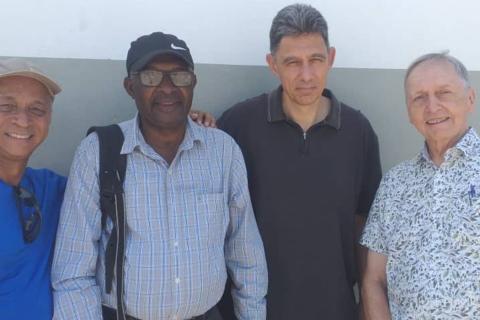“Paradise ’49”, meeting former Prime Minister De Gasperi and Pasquale Foresi

Focolarini during 1949 at the Dolomites
From Trent in northern Italy, Chiara Lubich reached Rome in December 1948, together with three of her friends. Elena Hoehn, a woman of noble status, and her husband Commander Alvino offered them an apartment where they could live.
Shortly afterwards, on January 20, 1949, Chiara met a small group of legislators working in Montecitorio, the Italian Parliament. She drafted for them an action plan that was aimed at “making Jesus live in Parliament” that is, by “becoming saints: each one responsible for the others as for themselves.”
The fire of God’s love that she came to bring into that city was not only to revitalize convents and parishes, but also to give new life to every corner of society, in all its components, beginning with politics.
In those years Rome was in great turmoil, struggling to recover from the moral and material destruction caused by the war. The ecclesial world, too, was trying to infuse renewed energy into Christian life. Various groups came to life, such as the Crusade of Charity founded by Fr. Leone Veuthey and the Regnum Christi Movement, promoted by Fr. Beda Hernegger. Chiara had met with them and was invited to collaborate together.
At that time there were only 19 women and four men focolarini. They made up a tiny group, but possessed such ardor that they seemed like an army; it wasn’t by chance that they earned the nickname “incendiaries.”
After a few months, there was already a community around them of more than 3,500 people of all vocations, 300 of whom were in Rome. Some men religious, beginning with Fr. Raffaele Massimei, who was then director of the Franciscan Third Order, opened up the doors of their group meetings throughout the region of Lazio. Chiara also visited the island city of Sassari in Sardinia during the spring.
This new life was spreading everywhere, but then came a sudden halt. Chiara was diagnosed with tuberculosis. Following her doctor’s advice, she went back north to the hospital of Mesiano, above Trent. Yet after a thorough physical exam, she was declared perfectly healthy!
She declared afterwards that the suffering caused by the misdiagnosis was a particular reflection of Jesus, who on the cross felt abandoned and forsaken. This time, however, he appeared as a ghost, “but for us what remained was that we had loved him.”
That incident nonetheless pointed to the need for Chiara to get some rest and make the most of the summer. She bade farewell to the community in Rome with a letter dated June 1949: “Although we are far apart, some at the mountains and others by the seaside, a light will bind us together, indiscernible to the senses and unknown to the world, but dear to God and to unity more than anything else. It is the Word of Life. We can be truly one only on the condition that each one of us is another Jesus, another living Word of God.”
And so Chiara went back to her Trentino, to Tonadico, a village in the Dolomite Mountains. There she stayed in a little cabin, which was really just a barn, belonging to one of the focolarine, Lia Brunet.
“I have felt in my heart the passion that fills your heart for all of the forsakenness into which the whole world is drifting.”
Already before traveling, she was struck by something she saw as she was leaving: a title on a billboard, advertising the movie Off in the mountains I will carry you away. And she truly was carried away by the love of God in an experience of life and of light that made her understand the realities of heaven in a new way, an experience that they referred to as “Paradise ’49.”
As the summer of 1949 was drawing to a close, her concern over humanity’s sufferings became ever stronger. “Lord, give me all those who are lonely,” she prayed on September 1. “I have felt in my heart the passion that fills your heart for all of the forsakenness into which the whole world is drifting.”
When she returned to Rome, she found the same problems as before: lack of housing, unemployment, new immigrants, material and moral decline. She wrote in her diary: “Looking at Rome as it is now, I feel my ideal far away.”
But another vision superimposed itself onto that external picture, one that she had received from a light that had shone so intensely over the summer. This light made her foresee the “resurrection” of Rome and humanity in its entirety, fully engulfed by the fire of God’s love. It was as if this light came down with Chiara into the darkness of the world.
A herald of this was a meeting with Alcide De Gaspari, who at that time headed the government. Their first meeting took place informally in Fregene, outside of Rome, on a Sunday afternoon. De Gasperi was concerned because of a delay in aid due from the U.S. government, but he became enchanted by Chiara’s words and rediscovered hope.
“To feel that we are united, under the wings of the divine Fatherhood, gives a sense of serenity and trust,” he wrote to her, “even in this moment of tribulation. And this indeed is a troubled time.”
In the meantime new traveling companions joined Chiara on this journey. An elderly and wise religious, Fr. Giovanni Battista Tomasi (1866–1954), was assigned to be close to her during the foundational years of this new work of the Church.
Then there was also a young man from Tuscany (who later became a priest), Pasquale Foresi (1929–2015). Chiara had asked him if he would share with her the new divine adventure; he would eventually accompany her throughout the development of the Focolare, officially approved as the Work of Mary.
If you enjoyed this article, you might like...














